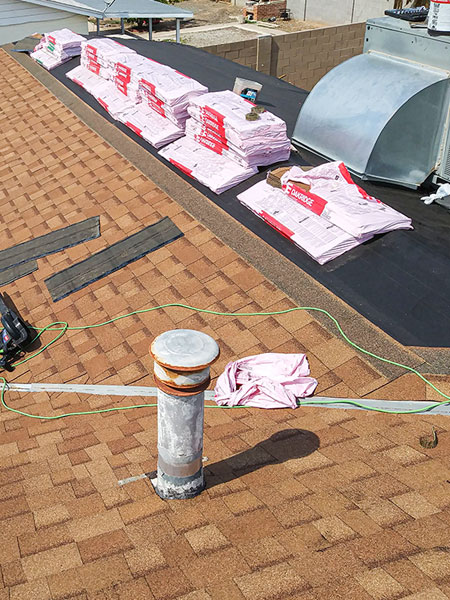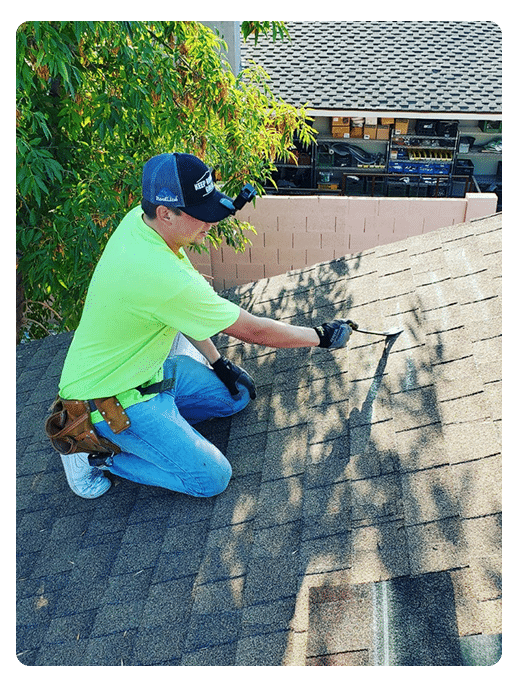Extreme weather conditions can have devastating effects on your roof. Knowing how to properly prepare it for harsh weather is essential in order to protect the home and its inhabitants.
This article provides a comprehensive guide as to what needs to be done in order to ensure that your roof is ready for whatever Mother Nature throws at it. From checking existing materials, to selecting appropriate replacements when necessary, this article will provide all of the information needed for successful preparation of your roof for extreme weather conditions.
Evaluate Your Roof’s Current Condition
Evaluating the current condition of a roof before harsh weather is essential to ensure its proper functioning. An experienced inspector or contractor should be hired to conduct an inspection, which should include evaluating for any damage that may have occurred due to storms or other sources.
The inspector should also look for signs of aging such as curling shingles, cracked flashing, and moss growth. Additionally, they can check for sagging gutters and make sure that all vents are sealed properly.
The inspection should provide detailed information on potential weaknesses in the roof’s structure and recommend repairs if necessary. Homeowners should keep in mind that some issues may not be visible from ground level; therefore, it is important to inspect both interior and exterior components of the roof.
Once any weak spots have been identified and addressed, homeowners can take additional steps to prepare their roof for harsh weather conditions.

Invest In Quality Materials
Investing in quality materials is essential when preparing your roof for harsh weather. High-quality shingles that are designed to resist wind and other elements, along with a properly installed flashing system, will help ensure the integrity of your roof over time.
Furthermore, installing an ice shield or underlayment beneath the shingles can provide additional protection against water penetration caused by melting snow or ice damming. Taking these measures before winter arrives can make all the difference in preserving the condition of your home’s roof during extreme conditions.
It is also important to ensure that gutters and downspouts are clean and free of debris so that they can effectively channel away rainwater. If necessary, consider investing in additional gutter covers to keep leaves and other debris from clogging up the system in more heavily treed areas.
Doing regular inspections throughout the year helps identify any potential issues before they become major problems and requires minimal effort compared to dealing with damage later on. Investing a bit up front pays off with added peace of mind knowing you have done what you can to protect your home from inclement weather.
Inspect For Damage
One of the most important steps to prepare a roof for harsh weather is to inspect it thoroughly for any damage. This can be done by looking at all angles, both inside and outside of the home. Any signs of wear or tear should be immediately addressed as they can cause further damage in extreme conditions.
Areas such as flashing, chimneys, vents and valleys should also be inspected carefully. Inspecting around the shingles, checking for missing nails or curling edges will help to ensure that your roof is in good condition before high winds and heavy rains come through.
The other critical step when preparing a roof for adverse weather conditions is sealing any cracks or holes that may have developed over time. It is essential to use proper protective materials that are designed specifically for outdoor environments so that these seals last longer during periods of bad weather.
If possible, one should also consider applying waterproof sealant beneath the shingles to provide an additional layer of protection from water infiltration. Doing this prior to storms coming in will help ensure your roof remains safe and secure even in intense weather conditions.
Clear Debris And Overhanging Limbs
Proper roof preparation for harsh weather requires more than just routine maintenance. In order to ensure that the roof can withstand extreme conditions, it is important to clear debris and overhanging limbs from around the area of the home.
Leaves, twigs, and other debris should be cleared from gutters and away from areas where water may collect during a storm. Further, any branches or foliage that are within close proximity to the roof should also be trimmed back in order to prevent them being blown against and damaging the roofing material.
By taking steps such as clearing out debris and trimming nearby trees, homeowners can add an extra layer of protection against strong winds, heavy rains, snowstorms, hail storms, and even hurricanes. While these tasks may seem laborious at first glance they provide invaluable protection when harsh weather strikes.
An ounce of prevention can save considerable effort down the road – not only protecting your property but potentially saving you thousands of dollars in repair costs.
Seal Openings And Vents
Sealing openings and vents is a crucial step in preparing your roof for harsh weather. It helps prevent water infiltration, which can lead to costly damage over time.
Start by inspecting the area around any penetrations or protrusions from the roof surface such as plumbing stacks, antennas, HVAC units, and exhaust fans. Make sure all of these are properly sealed with either flashing or sealant to ensure there are no gaps that could let moisture into the structure.
Additionally, check for any loose shingles or tiles along eaves and ridges; replace them if necessary to provide an extra level of protection against wind-driven rain.
Properly securing insulation within attic spaces can also help reduce heat loss during cold seasons while protecting against summertime condensation buildup.
Altogether, these steps will help protect your roof from potential damages caused by extreme temperatures and precipitation.
Inspect Gutters And Drains
Inspecting gutters and drains is an essential step in preparing your roof for harsh weather. Clearing out the debris from these areas helps ensure that water can be efficiently drained away from the structure, minimizing any potential damage caused by standing water or excess moisture.
Gutter systems should be checked regularly for blockages such as leaves, dirt, twigs, and other items that may have accumulated over time. If left unchecked, these obstructions can cause severe issues to occur; they not only impede normal drainage but also lead to leakage of rainwater into the building’s interior. Additionally, clogged downspouts will form pools of stagnant water on the roof which could cause significant structural damage if left unchecked.
It is important to inspect all pipes and drain outlets leading away from your roof too. These must remain unblocked in order for them to adequately channel runoff away from your home so that it doesn’t pool around foundations or low-lying areas where it could seep through cracks and potentially cause flooding inside the property.
Furthermore, check for rust on metal piping as this indicates corrosion which might need urgent attention before a major repair job becomes necessary. Regular maintenance of your guttering system will help reduce future problems resulting from heavy rainfall or snowmelt and ensure that no further harm comes to your roof during extreme weather conditions.

Apply A Protective Coating
Applying a protective coating to your roof is an essential part of preparing for harsh weather.
Depending on the surface material and location, you can choose from several types of coatings that will protect your roof from damage caused by wind, rain, snow, ice, and UV rays.
Acrylic-based coatings are among the most popular due to their ability to reflect light and heat away from the building’s interior as well as providing superior adhesion qualities for many surfaces.
In addition to painting or applying sealant with a brush or roller, there are also sprayable options available which allow for quick application over large areas in just one step.
Furthermore, using elastomeric coatings provides excellent protection against water infiltration while still allowing vapor diffusion through walls and roofs so they breathe naturally without accumulating moisture.
Conclusion
It is important to perform regular maintenance on your roof in order to prevent wear and tear during extreme weather conditions.
Taking the time to inspect for damage, seal openings and vents, clear debris and overhanging limbs, invest in quality materials and apply a protective coating can help ensure that your roof withstands harsh weather effectively.
Regular maintenance of these components will help prolong the life of your roof and protect it against potential damage caused by extreme temperatures or severe storms.
Allowing your roof to deteriorate due to lack of attention can be costly in the long run so taking proactive steps now can save you from expensive repairs down the road.


